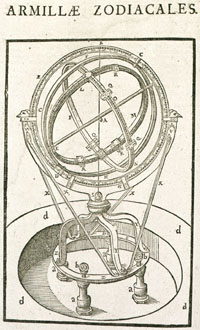The Observational Armillary Sphere
There is no certainty about whether the demonstrational or observational armillary sphere was produced first. While it has been suggested that Hipparchus may have produced and used an observational armillary sphere, the earliest clear reference to such an instrument is found in Ptolemy's Syntaxis; the Almagest as it was called in the Islamic world. In chapter one of book five, Ptolemy describes the construction and use of a zodiacal armillary sphere, an instrument for determining the locations of celestial bodies in ecliptic co-ordinates. In later chapters, Ptolemy gives instances of his use of this instrument, which he called an astrolabe, for observations of the stars and planets.Discussions of the observational armillary are also found in commentaries and paraphrases of the Syntaxis, such as those of Pappus (fl. 4th century A.D.) and Proclus (c. 412-485). Many Islamic astronomers wrote about the instrument, often again with referenced to the Syntaxis; an example is the discussion by Djabir b. Aflah (d. mid-12th century), called Geber in the Latin west, in his Correction of the Almagest. In addition, there is considerable evidence of the use of armillary spheres for observations, most notably at the Marâgha Observatory of the thirteenth century, the Samarkand Observatory of the fifteenth century, and the Istanbul Observatory of the sixteenth century.
 An image of a zodiacal armillary sphere, from Tycho Brahe's Mechanica.
An image of a zodiacal armillary sphere, from Tycho Brahe's Mechanica.
The observational armillary sphere was one of the instruments discussed in the Libros del Saber de astronomia produced under the auspices of King Alfonso X of Castile in the thirteenth century. This compilation drew heavily on Islamic astronomical expertise, and the description of the sphere is probably derived from an Arabic account by Abu Ishâq b. al Zarqâlî (1029-1087) which drew heavily on Ptolemy's Syntaxis. Later familiarity with the observational armillary in the Latin West derived mainly from Latin translations of Ptolemy's text. Regiomontanus wrote of the instrument as a Ptolemaic instrument, and his follower Bernard Walther (1430-1504) used one for some of an extensive series of observations he made in Nuremberg. Copernicus, in De Revolutionibus, followed Ptolemy in describing the construction and use of the armillary, but the only observations discussed by him which used the instrument were those of Ptolemy and Walther, or (as he thought) Hipparchus and Johann Schöner. Tycho Brahe constructed several armillary spheres, constructing them in both the zodiacal form and the equatorial configuration which established positions according to the equatorial co-ordinate system. Subsequent technological developments enabled more accurate observations but required instruments of correspondingly greater stability, and the use of armillary spheres was discontinued.
Independent development of the observational armillary occurred in China, and the instrument was an important item of observatory equipment from the first century A. D. Chinese observational armillary spheres were mostly of the equatorial form. They often enjoyed a feature more usually associated in the West with demonstrational instruments: an automatic rotation mechanism. A notable example is the water-driven armillary sphere which surmounted the astronomical clock-tower designed by Su Sung in the eleventh century. Western and oriental traditions of observational instruments eventually converged in the seventeenth century as a result of the Jesuit mission to China.